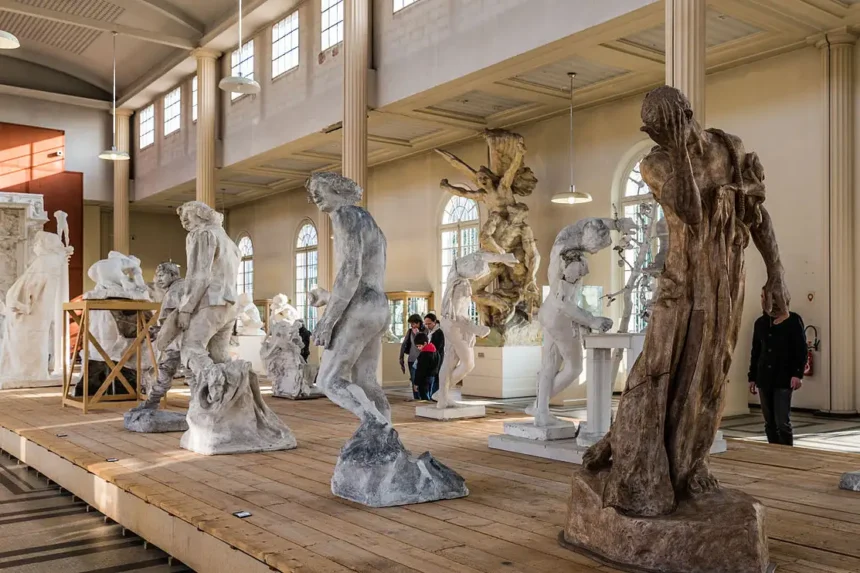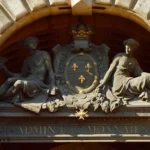Musée Rodin Paris: Step into a world of artistic passion and beauty at the Musée Rodin, a haven for art lovers and curious travelers alike. Nestled in the heart of Paris, this enchanting museum invites you to explore the genius of Auguste Rodin, one of the most celebrated sculptors of all time. Wander through the elegant Hôtel Biron, where Rodin once lived and worked, and discover his iconic masterpieces, such as “The Thinker,” “The Kiss,” and “The Burghers of Calais.”
Rodin’s Masterpieces: More Than “The Thinker”
While “The Thinker” is undoubtedly Rodin’s most recognizable work, the Musée Rodin houses a treasure trove of his other sculptures. Don’t miss the dramatic “The Kiss,” a passionate embrace frozen in time, or the poignant “The Burghers of Calais,” a monument to sacrifice and resilience. Explore the galleries to discover lesser-known but equally captivating sculptures, each revealing Rodin’s mastery of form and emotion.
Delve into Rodin’s creative process by observing his numerous studies and maquettes. These preliminary models offer a glimpse into the artist’s mind, showcasing the evolution of his ideas and techniques. You’ll see how Rodin experimented with different poses, expressions, and materials, refining his vision until he achieved the desired effect.
To truly appreciate Rodin’s genius, take the time to study the details of his sculptures. Notice the interplay of light and shadow on the bronze surfaces, the subtle nuances of expression on the faces, and the dynamic energy captured in the poses. Each sculpture is a masterpiece of observation and craftsmanship, inviting you to lose yourself in its beauty and meaning.
Hôtel Biron: A Mansion Turned Museum
The Musée Rodin is housed in the Hôtel Biron, a magnificent 18th-century mansion that once served as Rodin’s studio and residence. As you wander through the elegant rooms and grand salons, you’ll get a sense of the artistic atmosphere that inspired Rodin’s creativity. The mansion itself is a work of art, with its ornate décor and beautifully preserved architecture.
Take a moment to step outside and explore the mansion’s charming courtyard. Here, you’ll find a peaceful oasis surrounded by lush greenery and adorned with several of Rodin’s sculptures. The courtyard offers a delightful respite from the bustling city and a chance to reflect on the beauty of art and nature.
Don’t forget to visit the mansion’s upper floors, where you’ll find exhibits dedicated to Rodin’s contemporaries and followers. These displays provide valuable context for understanding Rodin’s place in the broader art world and his impact on subsequent generations of artists.
The Garden: Sculptures in a Lush Oasis
One of the highlights of the Musée Rodin is its expansive garden, where you’ll find a collection of Rodin’s sculptures nestled among verdant lawns, colorful flower beds, and tranquil ponds. As you stroll through the garden, you’ll encounter iconic works like “The Thinker,” “The Gates of Hell,” and “The Burghers of Calais” in a serene outdoor setting.
The garden offers a unique opportunity to experience Rodin’s sculptures in a natural environment, where the interplay of light, shadow, and foliage creates an ever-changing backdrop for the art. Take your time to wander along the winding paths, pausing to admire the sculptures from different angles and perspectives.
Don’t miss the rose garden, a fragrant haven filled with blooms in a variety of colors and scents. The rose garden is a popular spot for picnics and leisurely strolls, offering a romantic setting for couples and a peaceful retreat for solo travelers.
“The Gates of Hell”: Rodin’s Unfinished Epic
“The Gates of Hell” is a monumental sculpture that occupied Rodin for over two decades, yet remained unfinished at his death. This imposing bronze portal depicts scenes from Dante’s “Inferno,” showcasing a swirling mass of figures tormented by their sins. While incomplete, the sculpture is a testament to Rodin’s ambition and artistic vision.
Spend some time studying the intricate details of “The Gates of Hell.” You’ll find familiar figures like “The Thinker” and “The Three Shades” incorporated into the larger composition, along with countless other figures representing various human emotions and struggles. The sculpture’s sheer scale and complexity are awe-inspiring.
Although “The Gates of Hell” was never cast in bronze during Rodin’s lifetime, the Musée Rodin displays a plaster version that offers a glimpse into the artist’s intended design. The sculpture’s unfinished state adds to its intrigue, inviting viewers to ponder the mysteries of life, death, and the human condition.
Rodin & Camille Claudel: A Passionate Partnership
Camille Claudel was not only Rodin’s lover but also a talented sculptor in her own right. Their tumultuous relationship fueled both their artistic endeavors and personal lives. At the Musée Rodin, you can explore the intertwined stories of these two passionate artists.
Discover Claudel’s sculptures, which often depict themes of love, loss, and longing. Her works, such as “The Waltz” and “The Mature Age,” are characterized by their emotional intensity and expressive power. As you admire her sculptures, you’ll gain a deeper understanding of her artistic talent and the challenges she faced as a woman in a male-dominated field.
The Musée Rodin also showcases letters, photographs, and other personal artifacts that shed light on the complex relationship between Rodin and Claudel. Their story is one of passion, betrayal, and ultimately, heartbreak. Exploring this aspect of their lives adds a layer of depth and intrigue to their artistic legacies.
The Burghers of Calais: A Monument to Defiance
“The Burghers of Calais” is a powerful sculpture that commemorates the heroism of six citizens who offered themselves as hostages to save their city during the Hundred Years’ War. Rodin’s depiction of these men, with their heads bowed and bodies draped in sackcloth, is a poignant tribute to their courage and sacrifice.
As you observe “The Burghers of Calais,” take note of Rodin’s attention to detail. The expressions on the men’s faces convey a range of emotions, from resignation to defiance. Their ragged clothing and bare feet emphasize their vulnerability, while their resolute stances speak to their unwavering determination.
The sculpture’s placement in the Musée Rodin’s garden allows you to walk around it and view it from multiple angles. This immersive experience encourages you to contemplate the sacrifices made for the greater good and the enduring power of the human spirit.
Rodin’s Artistic Process: From Clay to Bronze
Rodin’s sculptures are renowned for their lifelike quality and emotional depth. To understand how he achieved this, explore the exhibits that showcase his artistic process. You’ll see how he began with sketches and clay models, gradually refining his ideas and experimenting with different forms.
Observe the tools and materials Rodin used in his studio, such as sculpting knives, calipers, and armatures. These tools provide insights into the physical demands of his work and the techniques he employed to bring his visions to life. You’ll gain a newfound appreciation for the time, effort, and skill involved in creating each sculpture.
The Musée Rodin also displays examples of the molds and casts used to create bronze sculptures. This process, known as lost-wax casting, allows for the reproduction of intricate details and the creation of multiple copies of a sculpture. By understanding this process, you’ll gain a deeper understanding of the technical aspects of Rodin’s craft.
Temporary Exhibits: Discover New Perspectives
In addition to its permanent collection, the Musée Rodin regularly hosts temporary exhibits that showcase the work of other artists or explore different aspects of Rodin’s life and career. These exhibits offer fresh perspectives on Rodin’s legacy and provide opportunities to discover new artistic connections.
Check the museum’s website or inquire at the information desk to see what temporary exhibits are on display during your visit. You might encounter works by Rodin’s contemporaries, sculptures by modern artists inspired by his style, or thematic displays that delve into specific aspects of his life or work.
The temporary exhibits at the Musée Rodin are a testament to the museum’s commitment to fostering dialogue and understanding between different artistic traditions. By engaging with these displays, you’ll broaden your knowledge of art history and gain a deeper appreciation for Rodin’s enduring influence.
Café Rodin: Enjoy Art & Refreshments
After exploring the museum and gardens, take a break at Café Rodin, a charming eatery located within the Hôtel Biron. Here, you can savor delicious French cuisine and refreshing drinks while surrounded by the elegant ambiance of the mansion. The café offers both indoor and outdoor seating, allowing you to enjoy the beautiful surroundings.
Choose from a variety of menu options, including sandwiches, salads, pastries, and coffee. The café also offers a selection of wines and other beverages, perfect for relaxing after a day of sightseeing. The friendly staff and welcoming atmosphere make Café Rodin an ideal spot to recharge and reflect on your museum experience.
In addition to its culinary offerings, Café Rodin often hosts special events, such as live music performances and poetry readings. Check the café’s schedule to see if any events coincide with your visit. These events add an extra dimension to your museum experience, combining art, food, and culture in a delightful setting.
Visitor Tips: Plan Your Musée Rodin Experience
To make the most of your visit to the Musée Rodin, plan ahead and consider these helpful tips. Purchase your tickets online in advance to avoid waiting in line, especially during peak season. Allow ample time to explore the museum and gardens, as there is much to see and discover.
Consider taking a guided tour to gain deeper insights into Rodin’s life and work. Tours are available in multiple languages and are led by knowledgeable guides who can answer your questions and share fascinating anecdotes. If you prefer to explore at your own pace, audio guides are also available.
Don’t forget to pick up a map and museum guide at the information desk. These resources will help you navigate the museum and gardens, ensuring you don’t miss any of the highlights. The guide also provides detailed information about the sculptures and exhibits, enhancing your understanding and appreciation of Rodin’s art.
Beyond Rodin: Exploring the Surrounding Area
The Musée Rodin is located in the heart of Paris, within walking distance of several other attractions. After your visit, consider exploring the nearby Invalides, a complex of museums and monuments dedicated to France’s military history.
If you’re in the mood for a leisurely stroll, head to the Champ de Mars, a large park that offers stunning views of the Eiffel Tower. Or, take a walk along the Seine River, where you can admire the city’s iconic bridges and architecture. The Musée Rodin’s central location makes it an ideal starting point for exploring the many wonders of Paris.
For those interested in art, the Musée d’Orsay, home to a vast collection of Impressionist and Post-Impressionist masterpieces, is just a short distance away. If you have more time, consider venturing further afield to explore the charming neighborhoods of Montmartre or the Latin Quarter, each with its own unique character and attractions.
Rodin’s Legacy: An Enduring Artistic Vision
Rodin’s sculptures continue to captivate and inspire audiences around the world. His innovative approach to form and his ability to capture the nuances of human emotion have earned him a place among the greatest artists of all time. As you leave the Musée Rodin, take a moment to reflect on the enduring power of his artistic vision.
Consider how Rodin’s sculptures have influenced subsequent generations of artists and continue to resonate with contemporary viewers. His works challenge us to think about the human condition, the power of love and loss, and the importance of individual expression. They invite us to see the world through new eyes and to appreciate the beauty and complexity of the human form.
The Musée Rodin is more than just a museum; it is a testament to the enduring power of art to inspire, challenge, and transform. Whether you are a lifelong art enthusiast or a casual visitor, a visit to the Musée Rodin is sure to leave a lasting impression.











